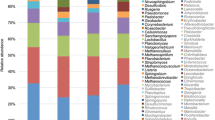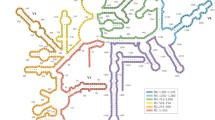Abstract
The sequencing of 16S and 23S ribosomal RNA (rRNA) molecules is currently the gold standard for the classification of new microbial isolates. Comparative analyses of these sequences are for the first time in the history of microbiology facilitating the reconstruction of universal phylogenetic trees [38]. Among many other important findings the work of Carl Woese and his colleagues demonstrated that only certain (by far not all) phenotypic/physiological groups of micro-organisms are monophyletic (e.g., methanogenes, cyanobacteria, spirochetes). About 10 years ago it has been proposed to use an rRNA approach for studies in microbial ecology [21]. The microbial diversity should be analyzed in a cultivation-independent way by direct rRNA sequence retrieval, whereas nucleic acid probes complementary to rRNA or rRNA genes should be the tools to monitor population dynamics in the environmental samples. By their own nature rRNA-targeted probes track genotypes which are not necessarily linked to one phenotype. Microbial ecologists who want to apply this approach to investigate correlations between community structures and functions should be aware of this fact and design or apply rRNA-targeted probes accordingly.
Access this chapter
Tax calculation will be finalised at checkout
Purchases are for personal use only
Preview
Unable to display preview. Download preview PDF.
Similar content being viewed by others
References
Amann RI, Binder BJ, Olson RJ, Chisholm SW, Devereux R, Stahl DA (1990) Combination of 16S rRNA-targeted oligonucleotide probes with flow cytometry for analyzing mixed microbial populations. Appl Environ Microbiol 56: 1919–1925.
Amann RI, Krumholz L, Stahl DA (1990) Fluorescent-oligonucleotide probing of whole cells for determinative phylogenetic, and environmental studies in microbiology. J Bacteriol 172: 762–770.
Amann RI, Stromley J, Devereux R, Key R, Stahl DA (1992) Molecular and microscopic identification of sulphate-reducing bacteria in multispecies biofilms. Appl Environ Microbiol 58: 614–623.
Amann R, Springer N, Ludwig W, Görtz H-D, Schleifer K-H (1991) Identification in situ and phylogeny of uncultured bacterial endosymbionts. Nature (London) 351: 161–164.
Amann R, Zarda B, Stahl DA, Schleifer K-H (1992) Identification of individual prokaryotic cells by using enzyme-labeled, rRNA-targeted oligonucleotide probes. Appl Environ Microbiol 58: 3007–3011.
DeLong EF (1992) Archaea in coastal marine environments. Proc Natl Acad Sci USA 89: 5685–5689.
DeLong EF, Frankel RB, Bazylinski DA (1993) Multiple evolutionary origins of magnetotaxis in bacteria. Science 259: 803–806.
DeLong EF, Wickham GS, Pace NR (1989) Phylogenetic stains: ribosomal RNA-based probes for the identification of single microbial cells. Science 243: 1360–1363.
Devereux R, Kane MD, Winfrey J, Stahl DA (1992) Genus and group-specific hybridization probes for determinative and environmental studies of sulphate-reducing bacteria. System Appl Microbiol 15: 601–610.
Embley TM, Finlay BJ, Brown S (1992) RNA sequence analysis shows that the symbionts in the ciliate Mctopus contortus are polymorphs of a single methanogen species. FEMS Microbiol Lett 97: 57–62.
Embley TM, Finlay BJ, Thomas RH, Dyal PL (1992) The use of rRNA sequences and fluorescent probes to investigate the phylogenetic positions of the anaerobic ciliate Mctopus palaeformis and its archaeobacterial endosymbiont. J Gen Microbiol 138: 1479–1487.
Fuhrman JA, McCallum K, Davis AA (1992) Novel major archaebacterial group from marine plankton. Nature (London) 356: 148–149.
Giovannoni SJ, Britschgi TB, Moyer CL, Field KG (1990) Genetic diversity in Sargasso Sea bacterioplankton. Nature (London) 345: 60–63.
Giovannoni SJ, DeLong EF, Olsen GJ, Pace NR (1988) Phylogenetic group-specific oligodeoxynucleotide probes for identification of single microbial cells. J Bacteriol 170: 720–726.
Hahn D, Amann RI, Ludwig W, Akkermans ADL, Schleifer KH (1992) Detection of micro-organisms in soil after in situ hybridization with rRNA-targeted, fluorescently labelled oligonucleotides. J Gen Microbiol 138: 879–887.
Johnson MT, Read BA, Manko AM, Pappas G, Johnson BA (1986) A convenient new method for desalting, deproteinizing, concentrating DNA or RNA. Biotechniques 4: 64–70.
Larsen N, Olsen GJ, Maidak BL, McCaughey MJ, Overbeek R, Macke TJ, Marsh TL, Woese CR (1993) The ribosomal database project. Nucleic Acids Res 21: 3021–3023.
Manz W, Amann R, Ludwig W, Wagner M, Schleifer K-H (1992) Phylogenetic oligodeoxynucleotide probes for the major subclasses of proteobacteria: problems and solutions. System Appl Microbiol 15: 593–600.
Manz W, Szewzyk U, Eriksson P, Amann R, Schleifer KH, Stenström T-A (1993) in situ identification of bacteria in drinking water and adjoining biofilms by hybridization with 16S and 23S rRNA-directed fluorescent oligonucleotide probes. Appl Environ Microbiol 59: 2293–2298.
Neef JM, Vandepeer Y, DeRijk P, Chapelle S, De Wächter R (1993) Compilation of small ribosomal subnit RNA structures. Nucleic Acids Res 21: 3025–3049.
Olsen GJ, Lane DJ, Giovannoni SJ, Pace NR, Stahl DA (1986) Microbial ecology and evolution: a ribosomal RNA approach. Ann Rev Microbiol 40: 337–365.
Poulsen LK, Ballard G, Stahl DA (1993) Use of rRNA fluorescence in situ hybridization for measuring the activity of single cells in young and established biofilms. Appl Environ Microbiol 59: 1354–1360.
Ramsing NB, Kühl M, Jörgensen BB (1993) Distribution of sulphate-reducing bacteria, 02 and H2S in photosynthetic biofilms determined by oligonucleotide probes and microelectrodes. Appl Environ Microbiol 59: 3820–3849.
Roller C, Wagner M, Amann, R, Ludwig W, Schleifer K-H (1994) In situ probing of Gram-positive bacteria with high DNA G+C content using 23S rRNA-targeted oligonucleotides. Microbiol 140: 2849–2858.
Sambrook J, Fritsch EF, Maniatis T (1989) Molecular Cloning. Second edition. Cold Spring Harbor Laboratory Press, Cold Spring Harbor USA.
Spring S, Amann R, Ludwig W, Schleifer, N Petersen K-H (1992) Phylogenetic diversity and identification of nonculturable magnetotactic bacteria. System Appl Microbiol 15: 116–122.
Spring S, Amann R, Ludwig W, Schleifer KH, Gemerden H van, Petersen N (1993) Dominating role of an unusual magnetotactic bacterium in the microaerophilic zone of a freshwater sediment. Appl Environ Microbiol 59: 2397–2403.
Springer N, Ludwig W, Amann R, Schmidt HJ, Görtz H-D, Schleifer K-H (1993) Occurrence of fragmented 16S rRNA in an obligate bacterial endosymbiont of Paramecium caudatum. Proc Natl Acad Sei USA 90: 9892–9895.
Springer N, Ludwig W, Drozanski V, Amann R, Schleifer K-H (1992) The phylogenetic status of Sarcobium lyticum, an obligate intracellular bacterial parasite of small amoebae. FEMS Microbiol Lett 96: 199–202.
Stackebrandt E, Liesack W, Goebel BM (1993) Bacterial diversity in a soil sample from a subtropical Australian environment as determined by 16S rDNA analysis. FASEB J 7: 232–236.
Stahl DA, Amann RI (1991) Development and application of nucleic acid probes in bacterial systematics (p. 205–248). In: Stackebrandt E, Goodfellow M. (eds) Sequencing and Hybridization Techniques in Bacterial Systematics. John Wiley and Sons, Chichester, England.
Stahl DA, Flesher B, Mansfield HR, Montgomery L (1988) The use of phylogenetically based hybridization probes for studies of ruminal microbial ecology. Appl Environ Microbiol 54: 1079–1084.
Szewzyk U, Manz W, Amann R, Schleifer K-H, Stenström T-A (1994) Growth and in situ detection of a pathogenic Escherichia coli in biofilms of a heterotrophic water bacterium by use of 16S- and 23S-rRNA-directed fluorescent oligonucleotide probes. FEMS Microbiol Ecol 13: 169–175.
Torsvik V, Goksoyr J, Daae FL (1990) High diversity of DNA of soil bacteria. Appl Environ Microbiol 56: 782–787.
Wagner M, Amann R, Kämpfer P, Aßmus B, Hartmann A, Hutzier P, Springer N, Schleifer KH (1994) Identification and in situ detection of gram-negative filamentous bacteria in activated sludge. System Appl Microbiol 17: 405–417.
Wagner M, Amann R, Lemmer H, Schleifer KH (1993) Probing activated sludge with oligonucleotides specific for proteobacteria: inadequacy of culture-dependent methods for describing microbial community structure. Appl Environ Microbiol 59: 1520–1525.
Wallner G, Amann R, Beisker W (1993) Optimizing fluorescent in situ hybridization of suspended cells with rRNA-targeted oligonucleotide probes for the flow cytometric identification of micro-organisms. Cytometry 14: 136–143.
Ward DM, Weller R, Bateson MM (1990) 16S rRNA sequences reveal numerous uncultured micro-organisms in a natural community. Nature (London) 345: 63–65.
Woese CR (1987) Bacterial evolution. Microbiol Rev 51: 221–271.
Zarda B, Amann R, Wallner G, Schleifer KH (1991) Identification of single bacterial cells using digoxigenin-labelled, rRNA-targeted oligonucleotides. J Gen Microbiol 137: 2823–2830.
Author information
Authors and Affiliations
Editor information
Editors and Affiliations
Rights and permissions
Copyright information
© 1995 Springer Science+Business Media Dordrecht
About this chapter
Cite this chapter
Amann, R.I. (1995). In situ identification of micro-organisms by whole cell hybridization with rRNA-targeted nucleic acid probes. In: Akkermans, A.D.L., Van Elsas, J.D., De Bruijn, F.J. (eds) Molecular Microbial Ecology Manual. Springer, Dordrecht. https://doi.org/10.1007/978-94-011-0351-0_23
Download citation
DOI: https://doi.org/10.1007/978-94-011-0351-0_23
Publisher Name: Springer, Dordrecht
Print ISBN: 978-94-010-4156-0
Online ISBN: 978-94-011-0351-0
eBook Packages: Springer Book Archive




